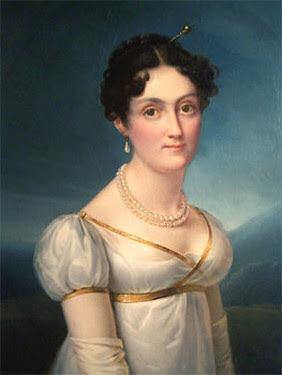
Elizabeth Patterson Bonaparte

"She possessed the pure Grecian contour; her head was exquisitely formed, her forehead fair and shapely, her eyes large and dark, with an expression of tenderness that did not belong to her character; and the delicate loveliness of her mouth and chin, the soft bloom of her complexion, together with her beautifully rounded shoulders and tapering arms, combined to form one of the loveliest of women." -quote about Elizabeth Patterson Bonaparte, by an unknown admirer
Elizabeth Patterson Bonaparte was born Baltimore, Maryland, February 6 1785, the eldest of 13 children . Known as "Betsy", she was the daughter of a Baltimore, Maryland merchant, the first wife of Jérôme Bonaparte, and sister-in-law of Emperor Napoleon I of France. Elizabeth's father, William Patterson, had been born in Ireland and came to North America prior to the American Revolutionary War. He was a Catholic, and the wealthiest man in Maryland after Charles Carroll of Carrollton, a signer of the United States Declaration of Independence. Elizabeth's brother, Robert, married Carroll's granddaughter, Marianne Caton (but more on her later...) How they met is a mystery, but Elizabeth and Jérôme Bonaparte (at the time 18 and 20, respectively) were married on December 24, 1803, at a ceremony presided over by John Carroll, the Archbishop of Baltimore. Betsy quickly became known for her "risqué" taste in fashion, starting with her wedding dress.
 Jérôme's brother Napoleon ordered him back to France and demanded that the marriage be annulled. Jérôme ignored Napoleon's initial demand that he return to France without his wife. When Napoleon threatened to imprison him, Elizabeth's brother rushed to France to intervene, but nothing would change the mind of the French dictator who had far grander plans for his brother than some American socialite. When James Madison and even Tallyrand could do nothing about the situation, Jérôme and a pregnant Betsy attempted to travel to France. It was the fall of 1804 and they hoped to arrive in time for Napoleon's coronation, but a number of false starts delayed them. When they finally arrived, Elizabeth was denied permission to set foot in continental Europe by order of Napoleon. Jérôme traveled to Italy in an attempt to reason with his brother, writing to his wife,
Jérôme's brother Napoleon ordered him back to France and demanded that the marriage be annulled. Jérôme ignored Napoleon's initial demand that he return to France without his wife. When Napoleon threatened to imprison him, Elizabeth's brother rushed to France to intervene, but nothing would change the mind of the French dictator who had far grander plans for his brother than some American socialite. When James Madison and even Tallyrand could do nothing about the situation, Jérôme and a pregnant Betsy attempted to travel to France. It was the fall of 1804 and they hoped to arrive in time for Napoleon's coronation, but a number of false starts delayed them. When they finally arrived, Elizabeth was denied permission to set foot in continental Europe by order of Napoleon. Jérôme traveled to Italy in an attempt to reason with his brother, writing to his wife,
“My good wife, have faith in your husband. The worst that could happen now would be for us to have to live quietly in some foreing country….My dearest Elisa, I will do everything that must be done.”
After remaining in limbo, unable to disembark in either France or the Netherlands, Betsy made her way to England, where she gave birth to a son on July 7, 1805, at 95 Camberwell Grove, Camberwell, London. She would never see her husband again. Jérôme, threatened with loss of rank and title, and being forced to account for his staggering debt, gave in to his brother, returned to the French Navy, and was created 1st Prince of Montfort and King of Westphalia, which he ruled from 1807 until 1813. The Pope had refused to allow a divorce or annul his marriage to Elizabeth, but that did not stop Napoleon-- the man who crowned himself emperor--from dissolving it himself, and forcing his young brother to marry a German princess Catharina of Württemberg.
Once king of Westphalia, his lavish lifestyle and constant philandering brought censure and as Napoleon's hold on the empire fragmented, Jérôme's fortunes fell as well. Eventually, he had two more children with his German wife, before marrying an Italian widow. His final placement came as governor of Les Invalides, Paris, the burial place of his lauded brother.
As King of Westphalia, Jérôme offered Elizabeth a home within his dominions, with the title of Princess of Smalcalden and a pension of two hundred thousand francs per year. In regard to the former, she replied that Westphalia was a large kingdom, but not quite large enough for two queens, and with regard to the pension, having already accepted Napoleon's annuity of sixty thousand francs, she made the oft-quoted response that she preferred "being sheltered under the wing of an eagle to being suspended from the bill of a goose." Famous American Belles of the Nineteenth Century, Virginia Tatnall Peacock, K. B. Lippincott Company, 1901Betsy returned to Baltimore with her son, Jerome Napoleon Bonaparte, called "Bo" by his mother, and lived with her father while she continued to flaunt her royal connection and skimpy attire. After the Battle of Waterloo, she returned to Europe, She styled herself "Madame Bonaparte". Here, she was well received in the most exclusive circles and much admired for her beauty and wit. In 1815, by special Act of the Legislature of Maryland, she at last secured a divorce. Her last years were spent in Baltimore in the management of her estate, the value of which she increased to $1.5 million. Betsy died in the midst of a court battle over whether the state of Maryland could tax her out of state bonds. The case reached the Supreme Court (Bonaparte v. Tax Court, 104 U.S. 592) where the Court decided in favor of Maryland. She is buried in the Greenmount Cemetery, Baltimore, Maryland. Her grandson, Charles Joseph Bonaparte, served as United States Secretary of the Navy and United States Attorney General. He founded the precursor of the Federal Bureau of Investigation in 1908.
 Ironically, Betsy's brother's widow, Marianne (Caton) Patterson, married Richard Wellesley, 1st Marquess Wellesley, older brother of Arthur Wellesley, 1st Duke of Wellington. The Caton sisters, born to the wealthiest man in Maryland (and the last surviving signer of the Declaration of Independence, who built what he claimed was “the most English house in America” ) were social climbers in the extreme. Of this six marriages made by the four sisters (Marianne, Bess, Louisa and Emily) three of them were to titled English nobility. Like the Irish Lennox sisters, a generation before, these heiresses, to quote a Carroll cousin, had the privilege , “[Had] the liberty of refusing those we don’t like, but not of selecting those we do.” Obviously, they, like so many American heiresses to come, liked titles and land, however entailed the estate might be. That two women, so closely related to an orchestrator of the American Revolution should marry a Bonaparte and a Wellesley-- that their respective brothers-in-law should be arch enemies and international heroes, seems beyond believing , but as they say, "truth is stranger than fiction". The stories of these amazing ladies have been told both in print and on film. Biographies include, Elizabeth Patterson Bonaparte: An American Aristocrat in the Early Republic and Sisters of Fortune: America’s Caton Sisters at Home and Abroad. The story of Elizabeth and Jérôme's marriage and annulment is the basis for the 1908 play Glorious Betsy by Rida Johnson Young and the two film adaptations, Glorious Betsy (1928) and Hearts Divided (1936). She was portrayed by Dolores Costello in the former and by Marion Davies in the latter. The episode "Duty" of the Hornblower television series features Elizabeth and Jérôme trying to land in France and the diplomatic difficulties.
Ironically, Betsy's brother's widow, Marianne (Caton) Patterson, married Richard Wellesley, 1st Marquess Wellesley, older brother of Arthur Wellesley, 1st Duke of Wellington. The Caton sisters, born to the wealthiest man in Maryland (and the last surviving signer of the Declaration of Independence, who built what he claimed was “the most English house in America” ) were social climbers in the extreme. Of this six marriages made by the four sisters (Marianne, Bess, Louisa and Emily) three of them were to titled English nobility. Like the Irish Lennox sisters, a generation before, these heiresses, to quote a Carroll cousin, had the privilege , “[Had] the liberty of refusing those we don’t like, but not of selecting those we do.” Obviously, they, like so many American heiresses to come, liked titles and land, however entailed the estate might be. That two women, so closely related to an orchestrator of the American Revolution should marry a Bonaparte and a Wellesley-- that their respective brothers-in-law should be arch enemies and international heroes, seems beyond believing , but as they say, "truth is stranger than fiction". The stories of these amazing ladies have been told both in print and on film. Biographies include, Elizabeth Patterson Bonaparte: An American Aristocrat in the Early Republic and Sisters of Fortune: America’s Caton Sisters at Home and Abroad. The story of Elizabeth and Jérôme's marriage and annulment is the basis for the 1908 play Glorious Betsy by Rida Johnson Young and the two film adaptations, Glorious Betsy (1928) and Hearts Divided (1936). She was portrayed by Dolores Costello in the former and by Marion Davies in the latter. The episode "Duty" of the Hornblower television series features Elizabeth and Jérôme trying to land in France and the diplomatic difficulties. Information from:
- The Encyclopedia of the Exquisite: The Baltimore Bonaparte
- Wikipedia: Elizabeth Patterson Bonaparte, Jerome Napoleon Bonaparte
- Access Genealogy: Elizabeth Patterson Bonaparte
- Elizabeth Patterson Bonaparte: An American Aristocrat in the Early Republic
- NY Times Book Review: Sisters of Fortune: America’s Caton Sisters at Home and Abroad.



Leave a comment
This site is protected by hCaptcha and the hCaptcha Privacy Policy and Terms of Service apply.